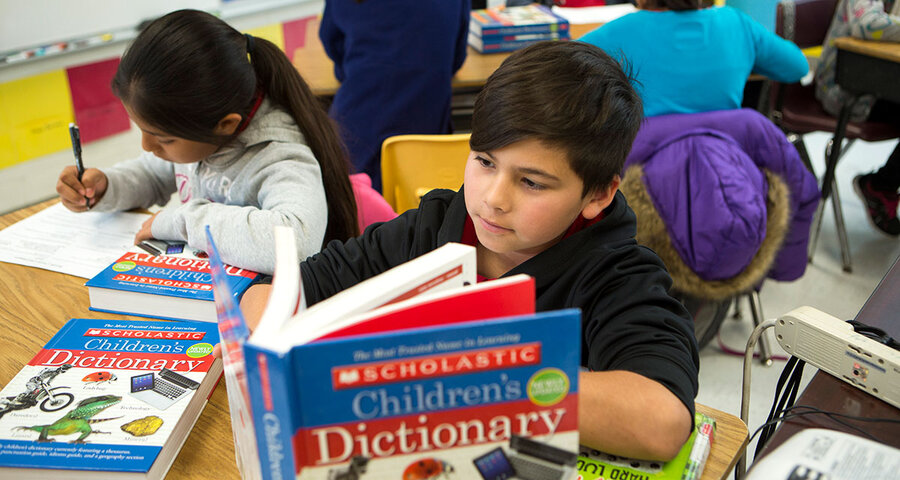National testing: What does it mean for a student to be 'proficient'?
Loading...
The word “proficient” is often used to mean suitable, apt, or at best, competent. An amateur cook, student driver, or French 101 student, for example, might describe his or her skills as proficient.
But the National Assessment of Educational Progress (NAEP) – the only national assessment in the United States since 1990, used as a barometer of student achievement – defines proficiency as “demonstrated competency over challenging subject matter,” which experts interpret as high achievement.
This mismatch in definitions causes a lot of confusion when it comes to analyzing scores from “The Nation’s Report Card” every two years. On Tuesday, for example, when NAEP’s 2017 scores were released, it was again evident that analysts and journalists use proficiency as the bar for success, citing that only 30 to 40 percent of 4th and 8th graders in the US are “proficient” in math and reading.
Critics say NAEP’s far-reaching definition of “proficient” can directly impact students’ education through inflated standards in widely used curricula like Common Core, low morale among teachers and administrators, and unnecessary confusion and disappointment for average Americans. Students in the US are actually improving, say observers, especially over the long term, and NAEP’s nomenclature can shroud legitimate progress that has been made in education.
“We have gotten an earful from our stakeholders about the confusion of the word ‘proficient’ as we use it,” says Peggy Carr, associate commissioner of the National Center for Education Statistics (NCES), the federal agency that oversees NAEP. “We get it, and we are trying to communicate this discrepancy, but it’s just not an easy task.”
Understanding what 'proficient' means
NAEP sorts students’ scores into three achievement levels: basic, proficient, and advanced. And to understand how many US students are performing on grade level, says Dr. Carr, it is far more accurate to look at “basic” scores, rather than “proficient.”
If headlines took this adjustment into account, and used the “basic” category, this week’s news might have focused on results showing that among US 4th graders, 68 percent perform on grade level in reading, and 80 percent perform on grade level in math. For 8th graders, these rates are 76 and 70 percent, respectively. Overall, scores remained largely the same as they were in 2015, but there is some concern among experts about equity: the highest-performing students made gains in the past two years, while the lowest performing students did worse.
When proficiency rates are interpreted correctly, however, they tell a different story about long-term trends: national proficiency rates in 4th and 8th grade math have doubled and tripled respectively since the early 1990s, and reading proficiency for both grades has increased by half.
NAEP’s aspirational standards might have something to do with these gains, says Sarah Theule Lubienski, a professor of math education at Indiana University, where she focuses on testing equity. NAEP was partially responsible for a big reform movement in math education around 1990, says Dr. Lubienski, in which algebra, probability, and geometry were added to elementary classrooms.
“NAEP was really out ahead… pushing the envelope and saying, ‘This is what we think students should know,’ ” says Lubienski. “It’s all in the name of holding high standards for students, making sure there is plenty of room to grow, and that has been achieved.”
Proficiency levels began flatlining in 2009-2010 once curriculum changes from 1990 became mainstream, says Luienski, but today’s plateau shouldn’t overshadow “incredible gains” over the last two decades.
After all, says Tom Loveless, a former senior fellow at the Brookings Institution and an education policy analyst, “proficient” as NAEP defines it is an incredibly high standard to uphold. For an 8th grade student to reach NAEP’s math proficiency today he or she must master the same concepts as a 12th grader in 1990.
These statistics are often twisted to fit a “reformist” narrative, says Dr. Loveless, by those who feel that the US education system needs a total overhaul.
“There is a huge group of people who want to tell everyone, ‘Look how bad our schools are,’ and ‘Look how ignorant our kids are,’ and they seize on [NAEP proficiency] because it fits their argument,” says Loveless.
Alternatives to current names
Carr says misconceptions about proficiency are not intentional on the part of NCES. NAEP’s terminology was decided back in 1988 – before the No Child Left Behind (NCLB) act, signed into law in 2002, used the term “proficient” to mean grade level performance, which then only muddled NAEP’s definition.
“The confusion really got started long after we released our naming convention,” says Carr.
Changing NAEP’s naming convention now would be a matter of policy for the National Assessment Governing Board, a group of 26 politicians, educators, and experts appointed by the Department of Education, who oversee achievement levels. And for a test whose reputation lies in reliable, direct year-over-year comparisons, changing names is extra tricky.
A January report by the National Superintendents Roundtable (NSR) and the Horace Mann League, titled “How High the Bar?,” recommends NAEP adopt benchmarks used by international education assessments, such as Progress in International Reading Literacy Survey (PIRLS) and Trends in International Mathematics and Science Study (TIMSS).
Their achievement levels of low, intermediate, high, and advanced would give more a neutral take on student scores, says James Harvey, executive director of NSR, without using the loaded words “basic” and “proficient.” And because NAEP informally uses the level “below basic,” Dr. Harvey says swapping in PIRLS and TIMSS’s four terms would be easy and allow NAEP to keep the scoring measures that give the test consistency.
“We tried to make it clear that we don’t mind high standards, we just want them labeled correctly,” says Harvey. “If they would stop using ‘proficient’ and replace with ‘high,’ we would be quite happy.”






